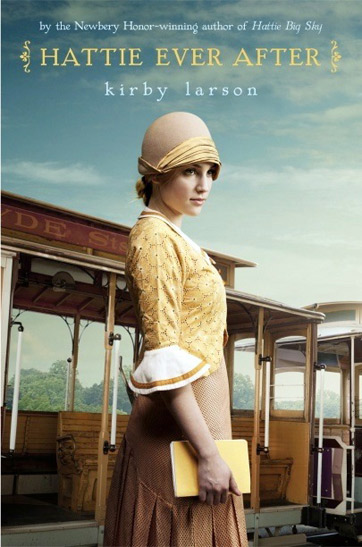When Kirby Larson revealed two years ago on Damsels that she was working on a sequel to her Newbery-honor book Hattie Big Sky, my comment was “Be still my heart!” And I meant it. Hattie Big Sky is one of my favorite books and it was the book my grad school mentor told me to study as a template for plotting a somewhat quiet, first-person historical novel. Kirby claims that she felt like Hattie’s story was over when her homesteading adventure came to a close. Glad to know I wasn’t the only reader who didn’t agree.
At her launch party in the indie bookstore near the Seattle suburb where Kirby and I both live, she showed pictures of fan letters begging to know what happened to Hattie next. To me and these letter-writers, there were enough loose ends in Hattie’s story that a sequel seemed almost a given. After writing two picture books and two middle grade novels, Kirby was finally persuaded to dig into this herself. The result:
 Is that not the most gorgeous, inviting cover you’ve ever seen? And it’s only the proverbial tip of the iceberg. Hattie Brooks, an orphan who called herself “Hattie Here-and-There” most of her life, has had a taste of a home of her own on the Montana prairie and is determined to settle into a permanent home somewhere. She takes a chance to get herself from Montana to San Francisco, where dreams of being a newspaper reporter begin to take shape. But a girl has to support herself on more than just dreams, so Hattie’s first newspaper job isn’t typing at a desk but rather cleaning the desks after the reporters go home for the night. On her “lunch” breaks, Hattie learns her way around the paper’s morgue, trying to find information about her Uncle Chester, who had lived there before coming to Montana. His only letter to her said that he had been a “scoundrel,” but Hattie will learn that scoundrels as well as kind souls come in all shapes and sizes.
Is that not the most gorgeous, inviting cover you’ve ever seen? And it’s only the proverbial tip of the iceberg. Hattie Brooks, an orphan who called herself “Hattie Here-and-There” most of her life, has had a taste of a home of her own on the Montana prairie and is determined to settle into a permanent home somewhere. She takes a chance to get herself from Montana to San Francisco, where dreams of being a newspaper reporter begin to take shape. But a girl has to support herself on more than just dreams, so Hattie’s first newspaper job isn’t typing at a desk but rather cleaning the desks after the reporters go home for the night. On her “lunch” breaks, Hattie learns her way around the paper’s morgue, trying to find information about her Uncle Chester, who had lived there before coming to Montana. His only letter to her said that he had been a “scoundrel,” but Hattie will learn that scoundrels as well as kind souls come in all shapes and sizes.
Oh, and remember Charlie, her school chum from Iowa? He has his own dreams for Hattie’s new home, and he won’t take no for an answer.
Some books I rush through to see what happens next, but this is one I savored, loving Hattie’s practical, humorous take on the world and Kirby’s painstaking attention to historical detail. Like all good historical novels, it made me want to travel to its setting, so a trip to San Francisco may be in my near future. But even if not, the book was definitely a satisfying answer to this fan’s pondering of “What happens next?”



 Posted by Emilie
Posted by Emilie 









